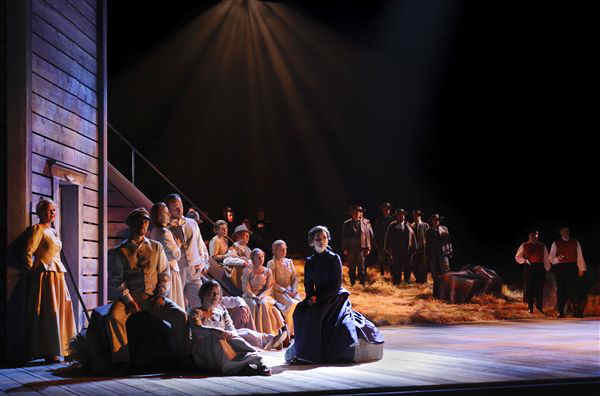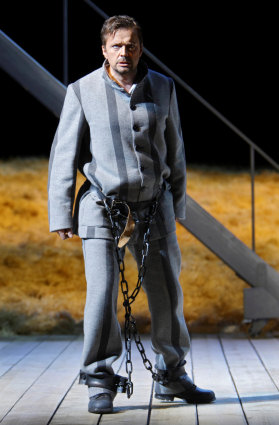Other Links
Editorial Board
-
Editor - Bill Kenny
-
Deputy Editor - Bob Briggs
Founder - Len Mullenger
Google Site Search
SEEN AND HEARD
INTERNATIONAL OPERA REVIEW
Leevi Madetoja, Pohjalaisia
:
(The Ostrobothnians)
Soloists,
Finnish National
Opera Chorus and Orchestra / Kari Kropsu, Finnish National Opera, Helsinki
14.4.2009 (GF)
It is a tightly knit drama and despite the brutality and the tragic outcome it
is also filled with warmth and humour. The music is late-romantic and to large
extent based on the folk music of the region. The overture, dark and ominous,
introduces the well known song Tuuli se taivutti koivun larvan, which is
later sung by Antti, and there are several other melodies as well – some of
which obviously were composed by Madetoja in a folk music idiom. There are also
several dance episodes where the folk fiddler tradition is ingeniously
incorporated. Madetoja’s masterly orchestration and his sense for atmosphere
makes this a coherent and deeply engaging work and it is easy to understand that
it is still the most frequently performed Finnish opera of all time.
Directed by Jussi Tapola
Sets by Hannu Lindholm
Costumes by Anna Kontek
Lighting design by Jukka Kyllönen
Choreography by Riikka Räsänen
Erkki Harri, freehold farmer, transporter of prisoners: Hannu Forsberg
Jussi Harri, son of Erkki Harri: Jussi Ziegler
Maija Harri, daughter of Erkki Harri: Riikka Rantanen
Liisa, a servant girl in the Harri household: Helena Juntunen
Antti Hanka, a young freehold farmer, prisoner: Jyrki Anttila
Kaisa, a dependent tenant on the Harri farm: Margit Westerlund
Salttu, a dependent tenant on the Harri farm: Mika Pohjonen
Kaappo, a farmhand on the Harri farm: Juha Riihimäki
Sheriff: Jyrki Korhonen
Lay judge: Raimo Laukka
Bridge
bailiff: Vel-Pekka Väisänen
Scrivener: Lassi Virtanen
Köysti of Karjanmaa,
a thug:Jouni Kokora
1st
herdsgirl: Tatjana Romanova-Vorontsova
2nd herdsgirl:Meriliinu Haataja

Riikka Rantanen as
Maija Harri and cast
He wrote two operas, The Ostrobothnians in the early 1920s and Juha
a decade later. Juha has never established a place in the standard
repertoire but The Ostrobothnians is widely regarded as a Finnish
national opera. Based on a play by Artturi Järviluoma but with a libretto by the
composer the opera takes place in Ostrobothnia along the Finnish west coast in
the mid-19th century, but the oppression by the Russian authorities
of the rural population actually mirrors the situation in 1914. Finland was an
autonomous part of the Russian empire but the Russians had begun to put the
screws on the stiff-necked Finns. The recurring theme is freedom and when the
opera was premiered on 25 October 1924 Finland was already an independent
nation, having declared its autonomy after the October revolution in 1917. The
premiere of the opera also marked the 1,000th performance at the
Finnish opera, which had begun its activities in 1911.
In The Ostrobothnians the young farmer Antti has stabbed a
neighbour and been placed in custody. Dressed in prison clothes he is allowed to
visit his fiancée Maija and her brother Jussi arranges that they can be alone.
The sheriff, who has tried to tame the Ostrobothnians with his whip, arrives and
demands to see Antti’s leave pass and Jussi hands it over without taking off his
hat. The sheriff knocks the hat off with his whip but Jussi snatches the whip
and breaks it.
In the second act the servant girl Liisa and Jussi fall in love and there is a
romantic scene of happiness. In sharp contrast Antti comes back, now in
shackles, and announces that he is being sent to prison. Maija tells him to run
away and decides to help him. A gang of thugs arrive and start a racket. It is
decided that they will sort things out in a wrestling match between Jussi and
the gang-leader. Jussi wins and the gang leaves the farm. Now it is discovered
that Antti has disappeared.
In the third act Liisa and Jussi are planning their wedding. The sheriff arrives
to carry through a hearing concerning Antti’s escape. The farmhand mentions that
he last saw Antti with Jussi. After a short ‘trial’ Jussi is clapped in irons
and is taken by the sheriff into a back room, where he is being whipped. Jussi
breaks his shackles and draws his knife. The sheriff shoots him twice but Jussi
still manages to stab the sheriff to death. Before dying Jussi says that the
Ostrobothnians will never give in to the slave-driver’s whip.

Jyrki Anttila as
Antti Hanka
I had never seen a staged production of The Ostrobothnians before
though I have been familiar with the music for many years in the shape of the
orchestral suite, compiled and performed even before the premiere of the opera.
There are also highlights on the more than thirty-year-old Finlandia recording
with Jorma Hynninen as Jussi. The premiere of this production was on 28th March
this year and the performance I saw was the fourth. It is beautifully staged
with two house entrances framing the beautifully lit ‘paintings’ and activities
on the backstage. Costumes and sets place the proceedings in the correct
historical time and the only thing that briefly confounded me – and probably the
rest of the audience – was the arrival of the thugs: two tanks-look-alike
vehicles arriving from above, giving the impression of an invasion from Mars.
Apart from this the realism is striking and no doubt contributes to conveying
the message of freedom.
There is a lot of action, of movements on the stage that is calculated but still
gives the impression of the spur of the moment. The wrestling match – overlong
according to my wife – is truly dramatic and full of life with people running
back and forth at breakneck tempo.
The premiere was conducted by General Music Director Mikko Franck, but at the
performance I saw Kari Kropsu had taken over. He was a new name to me but he
seemed well versed in Madetoja’s music, which must be second nature to most
Finnish conductors anyway. The role of Jussi was sung by Jussi Ziegler, whom I
saw as one of the gold-diggers in the National Opera’s La fanciulla del West
last autumn. It takes a lot to challenge Jorma Hynninen but Ziegler, born in
Germany in 1975, has his own integrity, singing and acting with confidence. He
had already sung the role at a concert performance in Pori in 2007. His Liisa
was the mercurial Helena Juntunen, who has rapidly risen to the top-drawer among
Nordic sopranos. Her Mimi in Bohème in Gothenburg was reportedly a great
success and Liisa is another feather in her cap. Riikka Rantanen as Maija was
slightly below her best in the opening song but improved through the
performance. As her fiancé Antti the superb Jyrki Anttila was in glorious form
and sang with impressive heroic tone.
Among the smaller roles Jyrki Korhonen was a towering Sheriff, less sonorous
than he once was but dramatically efficient. I praised Hannu Forsberg’s sonorous
Ashby in La fanciulla del West and here he turned in another fine
performance as Erkki Harri. Raimo Laukka once again showed that he is one of the
finest Finnish baritones, making much of his short outbursts as the Lay Judge.
Margit Westerlund and Mika Pohjonen were a splendid comic couple and Lassi
Virtanen drew a memorable portrait of the scrivener.
Göran
Forsling
Pictures © Heikki Tuuli
Back
to Top
Cumulative Index Page
